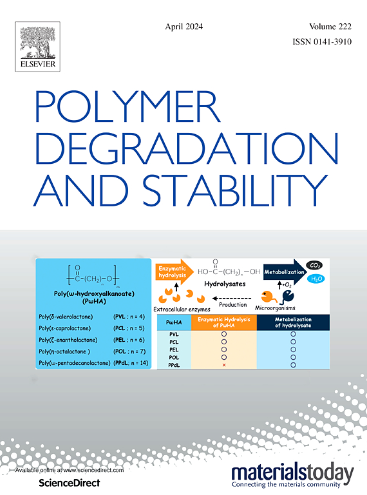Preparation of core-shell hybrid particles based on biomass resveratrol and phosphazene molecules co-assisted bimetallic ZIF achieves efficient flame-retardant modification and mechanical property enhancement of polyurea
IF 7.4
2区 化学
Q1 POLYMER SCIENCE
引用次数: 0
Abstract
The evolution of Spray Polyurea Elastomer (SPUA) technology has revolutionized protective coating materials. While market demands have accelerated polyurea (PUA) development, achieving high-performance fire-resistant formulations remains a critical challenge. In this study, a novel core-shell hybrid flame-retardant particle, FPM@ZIF-67/ZIF-8, was successfully synthesized through the precise assembly of bimetallic ZIF onto functional polyphosphazene microspheres (FPM). By strategically incorporating biomass-derived resveratrol and phosphazene molecules to introduce flame-retardant features, such as phosphorus-nitrogen heterocycles and aromatic rings, and capitalizing on the synergistic interaction between these structures and the smoke-suppressing properties of ZIFs, highly efficient flame-retardant PUA composites were successfully prepared. Specifically, the 5 wt % FPM@ZIF-67/ZIF-8 composite achieves UL-94 V-0 rating with limiting oxygen index (LOI) increasing from 20.3 % to 28.4 %. Relative to pure PUA, reductions of 41.6 %, 40.9 %, and 37.8 % were observed in pHRR, THR, and TSP, respectively. Furthermore, robust interfacial adhesion between FPM@ZIF-67/ZIF-8 particles and the PUA matrix, combined with efficient energy dissipation mechanisms, resulted in enhanced tensile strength (20.8 MPa) and elongation at break (1014.6 %). This study advances the design of bio-derived core-shell flame-retardant hybrids, facilitating the creation of high-performance PUA elastomers with balanced fire resistance and mechanical integrity. These findings hold substantial implications for broadening PUA applications in fire-sensitive domains.

基于生物质白藜芦醇和磷腈分子共助双金属ZIF制备核壳杂化颗粒,实现了聚脲的高效阻燃改性和力学性能增强
喷涂聚脲弹性体(SPUA)技术的发展已经彻底改变了保护涂层材料。虽然市场需求加速了聚脲(PUA)的发展,但实现高性能防火配方仍然是一个关键挑战。在本研究中,通过将双金属ZIF精确组装到功能性聚磷腈微球(FPM)上,成功合成了一种新型核壳杂化阻燃颗粒FPM@ZIF-67/ZIF-8。通过将生物质衍生的白藜芦醇和磷腈分子引入磷氮杂环和芳香环等阻燃特性,并利用这些结构与zif的抑烟性能之间的协同作用,成功制备了高效阻燃PUA复合材料。具体来说,5 wt % FPM@ZIF-67/ZIF-8复合材料达到UL-94 V-0等级,极限氧指数(LOI)从20.3%增加到28.4%。相对于纯PUA, pHRR、THR和TSP分别降低41.6%、40.9%和37.8%。此外,FPM@ZIF-67/ZIF-8颗粒与PUA基体之间强大的界面粘附,结合有效的能量耗散机制,导致抗拉强度(20.8 MPa)和断裂伸长率(1014.6%)提高。本研究推进了生物衍生的核壳阻燃复合材料的设计,促进了高性能PUA弹性体的产生,同时具有平衡的阻燃性和机械完整性。这些发现对扩大PUA在火灾敏感领域的应用具有重大意义。
本文章由计算机程序翻译,如有差异,请以英文原文为准。
求助全文
约1分钟内获得全文
求助全文
来源期刊

Polymer Degradation and Stability
化学-高分子科学
CiteScore
10.10
自引率
10.20%
发文量
325
审稿时长
23 days
期刊介绍:
Polymer Degradation and Stability deals with the degradation reactions and their control which are a major preoccupation of practitioners of the many and diverse aspects of modern polymer technology.
Deteriorative reactions occur during processing, when polymers are subjected to heat, oxygen and mechanical stress, and during the useful life of the materials when oxygen and sunlight are the most important degradative agencies. In more specialised applications, degradation may be induced by high energy radiation, ozone, atmospheric pollutants, mechanical stress, biological action, hydrolysis and many other influences. The mechanisms of these reactions and stabilisation processes must be understood if the technology and application of polymers are to continue to advance. The reporting of investigations of this kind is therefore a major function of this journal.
However there are also new developments in polymer technology in which degradation processes find positive applications. For example, photodegradable plastics are now available, the recycling of polymeric products will become increasingly important, degradation and combustion studies are involved in the definition of the fire hazards which are associated with polymeric materials and the microelectronics industry is vitally dependent upon polymer degradation in the manufacture of its circuitry. Polymer properties may also be improved by processes like curing and grafting, the chemistry of which can be closely related to that which causes physical deterioration in other circumstances.
 求助内容:
求助内容: 应助结果提醒方式:
应助结果提醒方式:


